
With the rise of social media, everyone has become their own publicist. Want to notify the world of what you ate for lunch? No problem, just open Instagram. Want to make a statement about culture, sports, or politics? Tweet it. Want to track the followers of your personal “brand”? There’s a Facebook app for that, too. Parts of this I love – namely self-expression and open dialogues – and other parts, especially the endless self-promotion, are a bit nauseating.
The old guard – folks who work hard and never talk about the elbow grease – may be a dying breed. But once in a while, you meet one and they stand out. Jeff Brandon (a friend of mine) is just that guy. He’s a kind, humble, and diligent assistant director of marketing at Mountain Hardwear. Why should you care? Because Jeff may have just changed the way you shop for outdoor clothing and gear in the future.
A small development team, led by Jeff, recently launched an Augmented Reality app that allows you to shop in a new way – virtually trying on outdoor gear in a photorealistic augmented reality with just your iPhone, all in the comfort of your living room. Instead of going downtown to try on a new shirt, you can save the gas and try it on instantly.

The idea started 18 months ago when VP of Marketing Snow Burns was dining at her favorite sushi restaurant, Sushi Sho. As he does every night, master chef Aki Kawata was chatting with his patrons and struck up a conversation with Snow, mentioning that his son worked at a cutting-edge agency in San Francisco. A few weeks later Mountain Hardwear connected with Transparent House, hoping they could partner on a few CGI renderings. It was soon obvious that they were onto something much bigger.
The goal for the app was simple from the start. Jeff and his team wanted to provide a more informed buying experience. Less time shopping would mean more time using and enjoying the gear.
The process was a “scholastic journey” according to Jeff, who admitted it pushed the company out of its comfort zone designing products like packs, tents, and technical outdoor apparel. Working closely with Transparent House, the team designed the wireframes and painstakingly perfected the fabric texture. When asked, Jeff laughed and said “I admittedly knew very little about AR or developing an app before kicking off this venture. Project managing the AR program has been an invaluable learning opportunity.”
The AR app enables users to view multiple products at once so they can create a customized kit for their needs. Users can easily change colors and sizes of the products at scale, too. They can view a tent in their living room, and then crawl inside to get a sense of the interior space. They can even have some fun viewing the product in one of four environments: forest, snow, cave, or studio. Then, if they want to make a purchase, the app points them to the closest retailer or the Mountain Hardwear website.
The initial release had slow adoption as one might expect when launching an industry first. Mountain Hardwear opted to let it grow organically before marketing the app heavily. Further, for traditional outdoor customers, shopping with AR is a big leap. In the last couple of months, though, the app has started to break the curve while engagement has stayed high with early adopters.
When asked about the future, Jeff was predictably honest. “It’s too early to tell whether this technology will be an essential part of our business, but we believe it’s important to keep evolving with our customers,” he said.
This fall Mountain Hardwear will launch their new GORE-TEX snow sports collection on the app, allowing users to view the collection at scale and build custom kits. “We’re really excited to see how customers react to this feature.”
You can download the app here.


